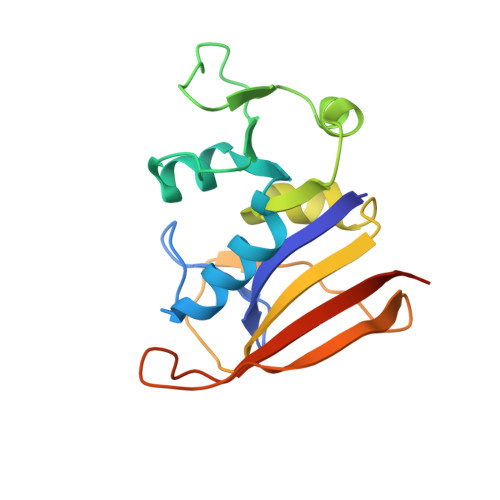Structure-Based Design of New Dihydrofolate Reductase Antibacterial Agents: 7-(Benzimidazol-1-yl)-2,4-diaminoquinazolines.
Lam, T., Hilgers, M.T., Cunningham, M.L., Kwan, B.P., Nelson, K.J., Brown-Driver, V., Ong, V., Trzoss, M., Hough, G., Shaw, K.J., Finn, J.(2014) J Med Chem 57: 651-668
- PubMed: 24428639
- DOI: https://doi.org/10.1021/jm401204g
- Primary Citation of Related Structures:
4LAE, 4LAG, 4LAH, 4LEK - PubMed Abstract:
A new series of dihydrofolate reductase (DHFR) inhibitors, the 7-(benzimidazol-1-yl)-2,4-diaminoquinazolines, were designed and optimized for antibacterial potency and enzyme selectivity. The most potent inhibitors in this series contained a five-membered heterocycle at the 2-position of the benzimidazole, leading to highly potent and selective compounds that exploit the differences in the size of a binding pocket adjacent to the NADPH cofactor between the bacterial and human DHFR enzymes. Typical of these compounds is 7-((2-thiazol-2-yl)benzimidazol-1-yl)-2,4 diaminoquinazoline, which is a potent inhibitor of S. aureus DHFR (Ki = 0.002 nM) with 46700-fold selectivity over human DHFR. This compound also has high antibacterial potency on Gram-positive bacteria with an MIC versus wild type S. aureus of 0.0125 μg/mL and a MIC versus trimethoprim-resistant S. aureus of 0.25 μg/mL. In vivo efficacy versus a S. aureus septicemia was demonstrated, highlighting the potential of this new series.
Organizational Affiliation:
Trius Therapeutics Inc. , 6310 Nancy Ridge Drive, San Diego, California 92121, United States.
















